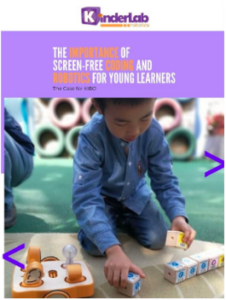District Administration: How Robots Excel at Access for Students with Autism
In this article, the author discusses how students on the autism spectrum find comfort in working with robots on coding, social-emotional skills and other subjects.
The article reads in part:
“The key to the effectiveness of any ed tech tool, including robots for children with autism, lies in whether students transfer the skills they’ve learned from schoolwork into their daily lives.
A range of autism robots also help special needs students learn core subjects and coding. The devices are highly effective because they provide students a safe space to experiment and near-instant feedback, educators and developers say.
“One advantage of coding and robots is that, especially with kids on the spectrum, it gives them the freedom to express what they’ve learned in a different way,” says Katie Caster, a K-5 STEM teacher at Oliver Hazard Perry School in Boston Public Schools. “That kind of authentic assessment is much more useful to me as a teacher.”
Few teaching tools captivate students as deeply as robots, says Caster, of Boston Public Schools. She uses the KIBO robot, by KinderLab Robotics, to teach lessons on math, animal life cycles and even fairy tales to students with autism, Down syndrome and other special needs.
KIBO, at first glance, could be mistaken for a toy that a child might use to learn shapes. But KIBO is all about programming and introducing children to computer science.
Children using KIBO place blocks with QR codes in a specific order, and then use a scanner to teach their program to the robot. They get to see if the robot follows their instructions.
For example, Caster’s students programmed KIBO to be the Big Bad Wolf. They recorded their voices saying “I’ll huff and I’ll puff,” and then built small houses out of different materials to test if the robot could run over them.
The activities transcend coding, math and language arts, and they help students develop key skills for problem-solving and creativity, following directions and staying on task, and working in a group and independently, Caster says.
“It brings all of those elements together to ensure there’s a variety of access points for each child,” she says.
Students who have trouble communicating and those who employ assistive devices to speak have also increased their use of language during and after their work with the robot. “They want to communicate,” Caster says. “They’ve become comfortable working in groups and are engaged enough to take risks.”
KIBO was designed to combine the concrete, real-world elements of blocks and the abstract thinking required for coding, says Jason Innes, KinderLab’s manager of training and curriculum development. “Some kids on the spectrum really connect with the robot because they like the fact that their commands are carried out exactly and predictably,” Innes says.
Students on the spectrum can use the robot to communicate. Teachers, for example, can have students create a map of their neighborhood or town, and then each child can program a story about what they did the previous weekend by making the robot drive around map to the park, library or shopping mall.
“It also keeps students off screens and in the physical world,” Innes says. “Children are learning abstract concepts and skills, but they can see concrete effects in the classroom.”
Read the full article.



















